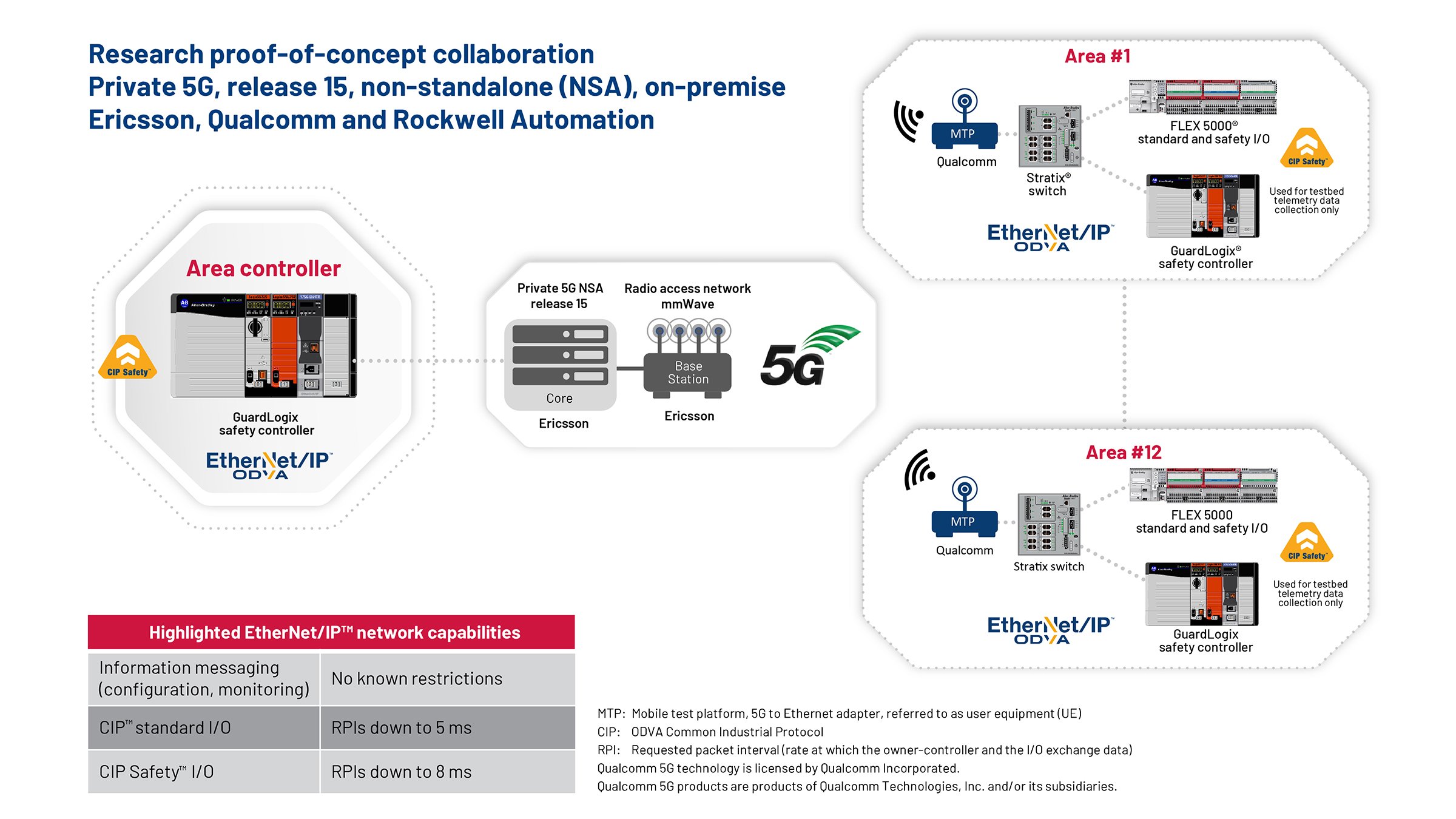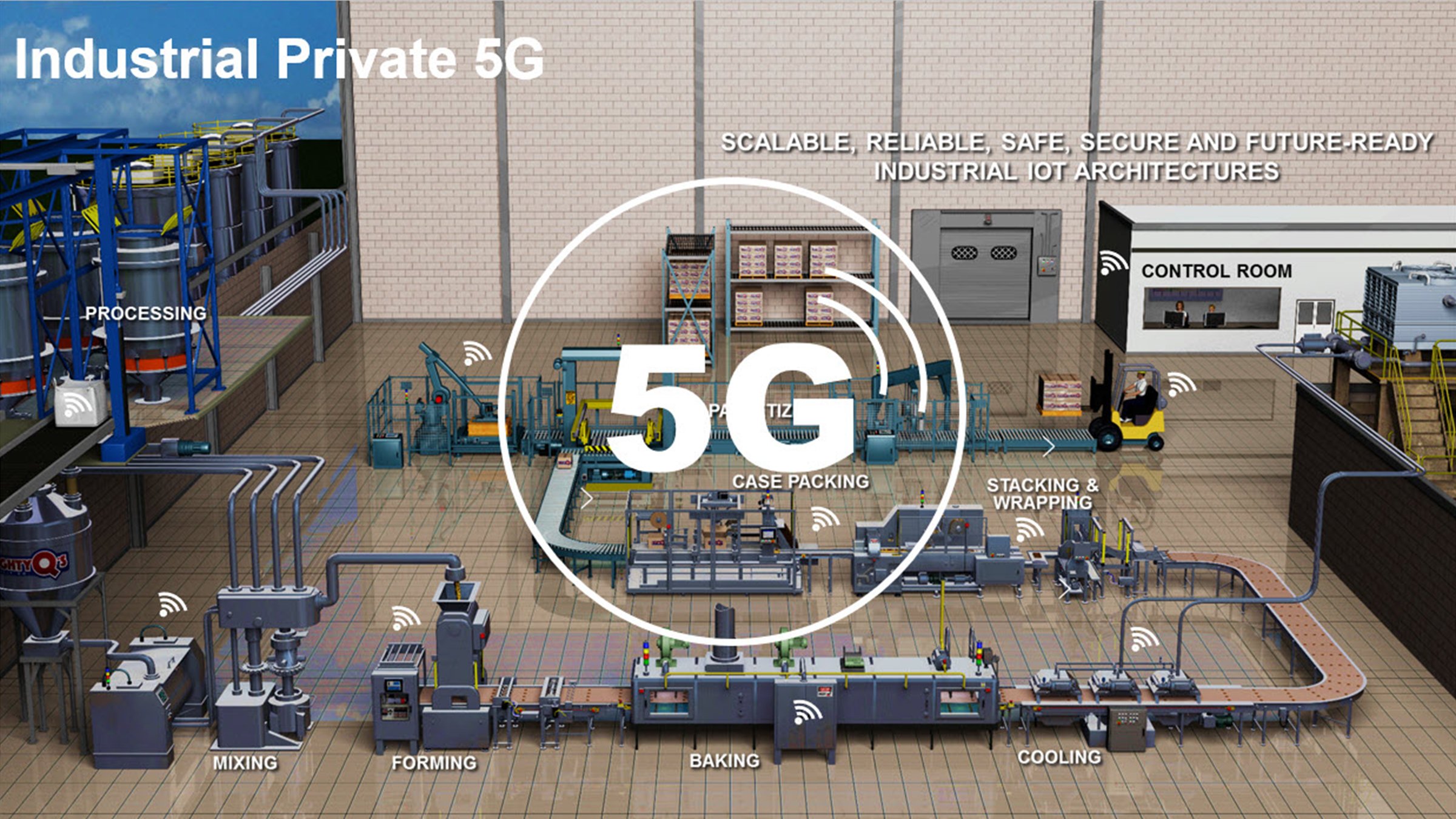Rockwell Automation: Private 5G Offers Sustainable and Agile Operations
EtherNet/IP is ready for industrial Private 5G
5G was designed from the ground up with ultra-reliability, low latency and a broad range of spectrum options in mind to meet the demanding requirements of Industrial IoT (IIoT) and industrial automation. With millimeter wave (mmWave) spectrum and private networks, 5G delivers these benefits for standard and safety control applications with numerous industrial sensors, actuators and controllers. 5G offers the promise of being a viable technology to augment and even replace traditional wired industrial network connections – a game changer in terms of cost, flexibility, sustainability and time-to-market for industrial operations around the world!
Sustainability policies are growing in importance across all industrial sector verticals. Adopting more sustainable policies is good for business. Tethered fixed industrial assets (skids, machines or equipment) require costly wired infrastructure for new installations; this material usage negatively impacts sustainability initiatives. Tethered fixed industrial assets also impact the agility of industrial operations by impeding quick retooling to respond to dynamic market conditions.
Yet, the entire manufacturing industry had to retool their industrial operations to meet shifting demand during the global pandemic: switching from soda to sanitizer, clothing to medical masks, or automotive parts to ventilators. The lesson is that agility, efficiency, resiliency and sustainability in smart manufacturing is a critical national imperative!
In comes industrial Private 5G, an enabler of digital transformation in smart manufacturing to help deliver business outcomes such as sustainability and agility by supporting key application use cases:
- Connected worker applications increase visibility and intelligence through mobile digital tools such as analytics, digital twins and augmented reality (AR).
- Mobile asset applications increase agility and efficiency with autonomous vehicles such as automated guided vehicles (AGVs) and autonomous mobile robots (AMR).
- Untethered fixed industrial asset applications improve sustainability by reducing the need for wired infrastructure to connect static equipment, static equipment with rotating parts (slip-ring replacement) and nomadic equipment (operational while static, non-operational while mobile). Untethered fixed industrial assets also increase agility by reducing the time to retool industrial operations to respond to changing market conditions.
Can industrial Private 5G help to enable these application uses cases within manufacturing and process operations?
To address this question Rockwell Automation (industry leader in industrial automation) collaborated with Ericsson (industry leader in cellular networking infrastructure), Qualcomm (industry leader in embedded devices) and Verizon (leading network service provider). The research collaboration evaluated industrial Private 5G technology with ODVA’s EtherNet/IP™, which is the core industrial communications technology used by Rockwell Automation. The key learning objective was to ensure that EtherNet/IP networks are ready for industrial Private 5G and to confirm that industrial Private 5G is ready for demanding EtherNet/IP applications.
The illustration is a simplified representation of the testbed developed. It represents an untethered fixed industrial asset application use case, consisting of:
- Rockwell Automation standard and safety control. One area controller with a GuardLogix® safety controller. Twelve distributed areas with FLEX 5000® standard and safety I/O, representing skids, machines or equipment. Note, the purpose of the safety controller in each distributed area was to collect testbed telemetry data only.
- Ericsson radio access network (RAN) infrastructure. Composed of a mmWave base station using 28 GHz (n261) and LTE band 2 using Release 15, and Private 5G core (3GPP Release-15, non-standalone (NSA), on-premise).
- Qualcomm MTP. A mobile test platform for data collection and traffic flow analysis, used as an industrial 5G to Ethernet adapter, referred to as user equipment (UE).
- Verizon’s thought leadership in industrial networking innovation with 5G was an important contribution towards defining requirements, target feature sets and scope of the testbed, including a roadmap of future validation requirements.

Tests were run according to a well-established test plan provided by Rockwell Automation with strict success criteria of zero faults. It outlined a series of test cases to establish reliable EtherNet/IP standard and safety (CIP Safety™) I/O connections from the GuardLogix area controller on the left, with a range of requested packet interval (RPI) settings, over the 5G RAN to the FLEX 5000 standard and safety I/O in areas 1 through 12 on the right. RPI is the rate at which the controller and the I/O exchange data.
The successful test results demonstrated that the current state of industrial Private 5G (3GPP Release-15, NSA, on-premise, mmWave spectrum) has low enough latency and jitter to support RPI settings that are better than the Rockwell Automation default settings for EtherNet/IP standard and safety I/O connections. These RPI settings will support many untethered fixed industrial asset applications (skids, machines or equipment) that use EtherNet/IP standard and safety I/O communications.
The outcomes of the learning objective emphasized:
- EtherNet/IP is ready for industrial Private 5G.
- The current state of industrial Private 5G is ready for EtherNet/IP standard and safety I/O applications.
- Industrial Private 5G can help to enable business outcomes such as increased sustainability and improved agility within industrial operations.
The research collaboration will continue. There are plans to evaluate EtherNet/IP time synchronization (CIP Sync™) and distributed motion (CIP Motion™) applications over 3GPP Release 16 standalone (SA) industrial Private 5G. The results of an initial proof-of-concept on a prototype testbed were promising.
In summary, thanks to Rockwell Automation, Ericsson, Qualcomm Technologies Inc. and Verizon, we are able to verify that real 5G enabled industrial automation test cases work as promised. Industrial operations can thus take advantage of the 5G standard today to meet their high-performance wireless connectivity and business assurance needs as they evolve toward smart manufacturing.


